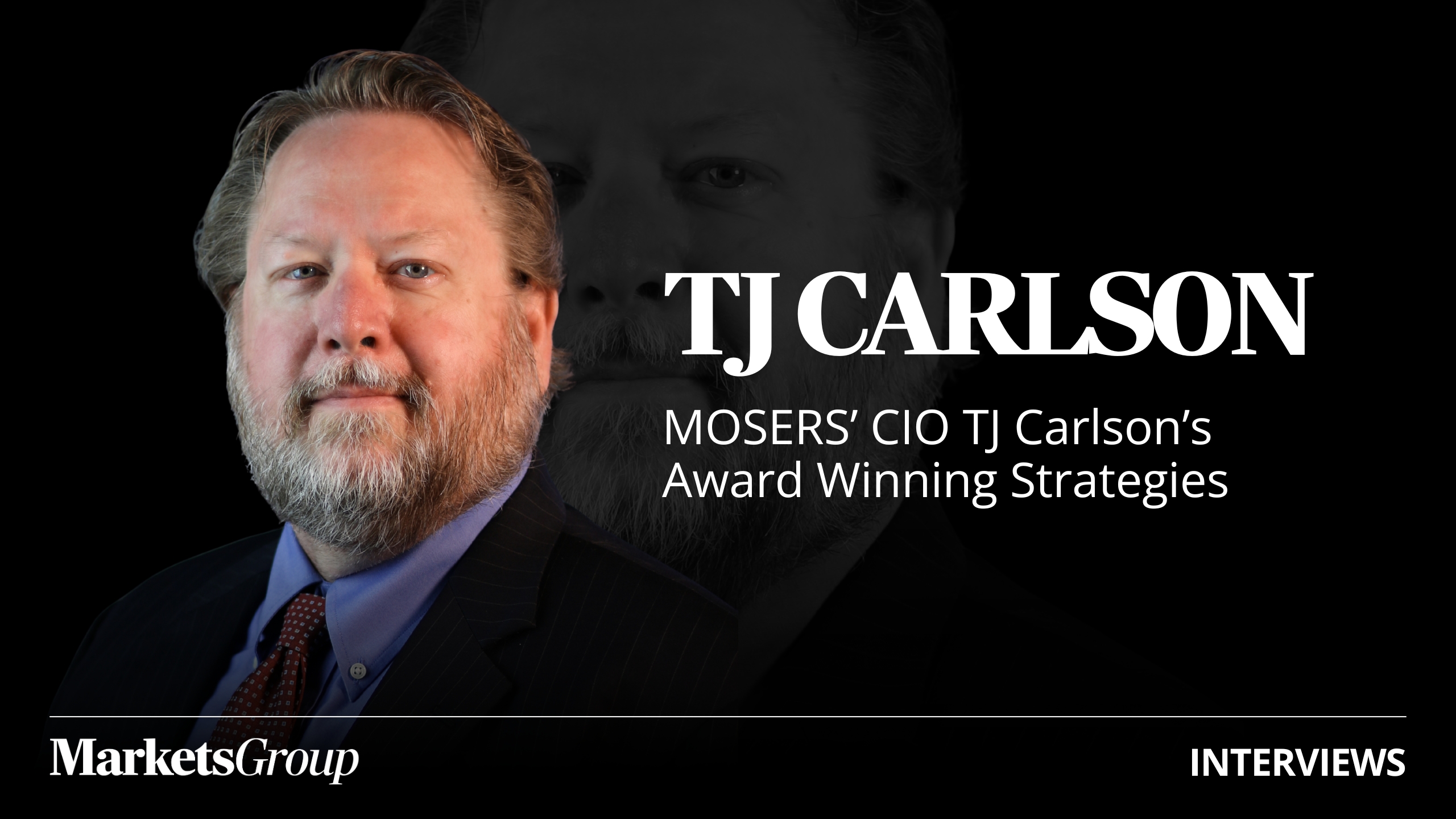Listen on Spotify
Ahead of being celebrated at the Markets Group July Summer Retreat, the CIO of Missouri State Employees’ Retirement System discusses his investment philosophy, strategic plans, vast career and growing CIO concerns.
By Christine Giordano
Often considered one of the key drivers for community among state pension chief investment officers, TJ Carlson is known for his leadership as well as his vast career. He is the chief investment officer of the Missouri State Employees’ Retirement System (MOSERS), a $9.5 billion system in capital with $12 billion in exposure as a levered portfolio, a position he has held for the past three years.
Carlson is about to win a peer-nominated Strategy award at the annual Summer Retreat for Markets Group on July 14-16 in Park City, Utah. He is planning some interesting strategies with portable alpha. In two separate time periods, the portable alpha portfolio at MOSERS has delivered between 250 and 300 basis points, and Carlson is planning to expand its application. This interview will also discuss his multifaceted career that has included Texas Municipal Retirement System, Kentucky Retirement System, a partner at Ennis Knupp, CIO of Marshfield Clinic, CIO of West Virginia Investment Management, and in the Marines for six years. Often a sounding board for state CIOs, Carlson will also discuss some of the concerns on their minds.
Watch the video interview here:
Transcript:
CHRISTINE GIORDANO: Welcome TJ
TJ CARLSON: Thanks, Christine. Good to be here.
GIORDANO: It’s great to have you. Let’s start from the top. Having been a Marine, how do you apply that to your approach and your investment management style?
CARLSON: I think that having a military background gives you certain skill sets and implementation styles that can work well across lots of different environments. I would probably say the first one starts with understanding a chain of command. Along with that chain of command comes a willingness to delegate and hold people accountable for that. That has served me well over time. People on my team enjoy when they get delegation. They get to help make decisions. That’s been a key component to what I feel like some of my successes are over time that came from the Marines.
One of the other things that I learned as I was coming up through the Marines and then becoming a leader there, which was don’t ask others to do things that you haven’t done or that you’re not willing to do today if you need to. Making sure that you’re just as invested in the outcome. If you need to pitch in and do an operational due diligence report because somebody had a family emergency and you still have a deadline, you’ve got to be willing to step up and do that and not use it as an excuse to not hit your goal.
Going along with that, I would say leading by example. Again, that’s whether it’s attendance or attention, your willingness to listen to different ideas and pitching in wherever you need to to make sure that the program is a success and that everybody on the team is a success, not just the CIO or the deputy CIO or whoever that’s going to come down to.
I would say one of the other things, because if you’ve ever been in the military, it’s a hurry up and wait. Being patient and being persistent are a couple of other keys to being successful in leadership, either in the military or at a pension fund, because everyone knows pension funds don’t change overnight. You have to be patient. You have to be persistent and have a long-term vision. Don’t get frustrated when you don’t get what you were trying to accomplish on the first go round. Go back and find another way to explain the situation or get more support for you so you keep working on it.
I guess one of the last things I would say is practice extreme ownership. I stole that title from a book by Jocko Willink, who’s a famous corporate speaker now and a former military person as well. In doing that, you have to understand and accept that everything that happens in your chain of command below you is ultimately your responsibility. Because if somebody under you fails to meet the goals that you laid out for them, it could be, number one, that they didn’t pay enough attention or didn’t listen when we were talking about it, or it was that you didn’t train them to do that activity well enough and you should have trained them more. This book by Jocko, I actually bought that book for all of my staff, both here at MOSERS and when I was at Texas, so I gave a copy to anybody who wanted it. It’s a good book.
GIORDANO: It’s got me thinking. You’ve been an insider working with the US government. You’ve also had a North American bias, if I read your portfolio correctly. Did being a Marine help you understand the workings of American government, of American industry, how these things work together, and give you a greater understanding as an investor?
CARLSON: I would say slightly different than that. I would say that being in the Marines and working at all of the different types of systems that I worked at, it gave me a bigger, broader appreciation for geopolitics and other people’s perspectives, and to always remember that it’s important to understand from somebody else’s point of view how are they viewing it. I would say that that was a very important thing as I was learning to work with individuals from different states or different countries. When I was in Desert Storm, we were part of a multinational force and had to interact with many other militaries from other countries, from all over the world. Being able to communicate and get on the same page with those people is very important.
GIORDANO: Then, you have experience from so many different pension funds. How do you apply that from your different roles in Texas, Kentucky, West Virginia, Ennis Knupp, and as CIO of Marshfield Clinic?
CARLSON: I think once you’ve been through the industry for as long as I have, we all become an accumulation of the different experiences that we have over time. I’ve been very fortunate to have a lot of varied experiences in my career. I feel like I’ve learned different things from each position that I apply all the time in many different situations. I would say that starting out with the public pension space, even at Iowa, West Virginia, and Kentucky, those were all three materially different governance structures. West Virginia is an investment board, Iowa is a lay board, Kentucky is a elected political, more political board. I took lessons from all of those different places and try to apply them wherever I’m at now.
Working at Marshfield Clinic, I was in charge of the reserve assets for an insurance company. We were self-insured for medical malpractice. We had an endowment. I led a tax-exempt debt issuance. I ran some DC plans there. Again, good experiences that help you think about things from different points of view as you’re doing that.
Then, with Texas, I had a much bigger pool of capital. It was almost $40 billion by the time I left there. Understanding capital pool size and its impact on the opportunity set that you can take advantage of, or frankly, the opportunity set you can’t take advantage of. Sometimes the opportunities are too small for you to efficiently and effectively take advantage of them when you’re a bigger pool.
Then I would say, finally, when I was at Ennis Knupp, I was very fortunate to work with the US government some. I worked with universities, hospital systems, two different state treasurer’s offices. I got a lot of good, varied experience as well there and how to think about things from another person’s point of view and what might be most important to them so that you can communicate with them effectively.
GIORDANO: In talking with you, TJ, you have a wonderful way of explaining things. Even in my experience over the years, you really seem to get down to a person’s level and break down major concepts for greater understanding. I can imagine that really helps you as an investor who talks across a vast array of experience sets. In that vein, can you talk about MOSERS, it has an ex-China mandate now, and how you’ve been leaning into your North American investment?
CARLSON: Sure. I guess there are two material points there. In December of 2023, the MOSERS board did an evaluation of the global public equity space and were somewhat concerned with the different layers of financial risks, less reporting consistency out of some of the Chinese markets, and then the different geopolitical risks that you hear about every day in the nightly news now. They made the decision to move our global public equity portfolio to an ex-China posture.
Since that time, we’ve been transitioning that portfolio and had to do some analysis about what did we believe the best way to implement that portfolio was. At the time, we were doing portable alpha in the US over the US benchmarks. However, we were doing active management in the non-US space for both developed and emerging markets. When we did this analysis, the ex-China universe of managers with material experience here, we found it to be, it is an up-and-coming practice for many different managers, but we were not comfortable being able to build an entire actively managed portfolio that we felt would give us decent levels of alpha plus consistent returns, consistent alpha.
We have such a long experience with portable alpha that we felt that that was a better opportunity for us. We transitioned at the same time that we transitioned to an ex-China posture by changing our underlying derivative that we have exposure to. We also moved away from the active management sleeve there, and we now do all of that through derivatives plus portable alpha.
GIORDANO: Okay. We’ll get into the layering of that in a bit.
CARLSON: Yes.
GIORDANO: Just wanted to lay the groundwork of the whole portfolio. You’ve also increased your private credit. In what areas have you done that?
CARLSON: Sure. Private credit is a vast and wide opportunity set, and so you can do this many, many different ways. About five years ago, we had very little in private credit, and then our board passed a new asset allocation that had a 5% allocation to private credit, and we started where many pension funds start, which is with the upper middle market, sponsor-backed, direct lending kinds of strategies, and then over time, we built out and added, too, some non-sponsored and lower-middle market types of strategies.
Then by the time we were getting close to our 5%, our board actually liked that portfolio quite a bit. The opportunity set kept growing, and so they moved the allocation up to 10% now, so now we’re in the process of going from 5% to 10%, and so we’re looking at other ways to diversify that asset class, and we’re adding now, too, some asset-backed deals, and then we’re also looking at opportunistic credit, and then finally, we’re evaluating whether or not we can come up with some unique account structures through separately managed accounts or some other method where we can do some multi-asset class implementation in that private credit space. We’re looking at some of that.
GIORDANO: Have you found anything fascinating?
CARLSON: It’s all fascinating in private credit. There are some pretty interesting ideas out there. The security risk transfer trades are pretty interesting, so we’ve been investing in those for about three years now, and I think lately we’ve been spending a lot of our time on trying to do structures and getting exposure to co-investments in these deals. How did each manager like to best give co-investment opportunities to different funds like us?
GIORDANO: Is there a certain niche in your co-investment projects that you really have enjoyed?
CARLSON: I wouldn’t say there’s any niche. I would say that the philosophy would be the higher we are up in the market, say upper middle market, the more we want exposure. As you move down into a more niche strategy, whether that be non-sponsored or very low middle market, for risk management purposes, we take a little bit less co-investment risk there. I would say that we look at it that way.
I would say the other thing that’s important when we talk about different co-investment opportunities for co-investing in private credit, we tend to want to have more exposure to more deals because we’re really just trying to get highly diversified additional low-cost exposure. Then we tend to do more deal-by-deal stuff in the equity space. Private equity co-investment, we want to be more selective.
GIORDANO: In your private credit portfolio, can you describe what you’re seeking within your complexity premium?
CARLSON: Sure. One of the opportunities that we like to look at, we don’t always take advantage of, is the fact that some allocators don’t want to either take the risk of more complex deals or they don’t have the time to spend to evaluate these deals. We tend to like to look at complex deals. We think that there can be a complexity premium once you’ve learned how to look at this space and evaluate it and you hire the right managers to work with.
We look for good firms in these spaces who have a history of embracing complexity. They have the teams that are built out, not only to do the deals when we’re looking at them, but also they already have in place the team that you need to help work it out if it doesn’t go as expected, because with complexity comes more work. You have to be ready for that. You have to be prepared for that. going back to the Marine Corps thing, you got to go be prepared for whatever comes your way. Making sure that you’re making good decisions, rational decisions, and you’re ready for all the potential outcomes of that is important when you’re doing more complex issues.
GIORDANO: Everybody loves a good comeback kid story or a success story, especially within this economy. Do you have any case examples that you might refer to on a high level?
CARLSON: I would say that one of the best examples I had that I would have is that we had an exposure and the company was going through a troubling time for their sector in the economy. The manager was still highly supportive of this company. In the end, there were many people who were trying to find a buyer for their exposures because they just wanted out and they were willing to take 15, 20 cents on the dollar.
We worked with that manager in a lot of detail over a very short period of time. We felt we were confident that once we got past about three to six months, that this was going to be money good. While it might not go from 20 to par, it was highly likely to go from 20 to 75, which is a great return. We actually bought up several of those exiting investors’ positions and added them to our account and it worked out really well.
GIORDANO: Nice, wonderful. You’ve also increased your private real assets. Any key takeaways there and in what areas?
CARLSON: Six years ago, we had two different allocations to real assets. We had real estate and then we had non-real estate real assets, but it was all in public real estate. It was basically an indexed REIT portfolio. In the last allocation last year, we changed that from a REIT allocation to a private non-real estate real assets. We’re looking at things there. We’ve added an agricultural fund. We’ve added some metals and mining. We’re looking at some infrastructure stuff. We’re looking at both primaries and secondaries. That seems to be a pretty attractive place right now. We’re continuing to build that out.
Longer term, my goal would be to do like we did with private credit. Hopefully, once we get close to the 5% mark, the board will like the portfolio that we’ve built and they’ll let us move that to 10%, because I think that would be a good opportunity for us longer term.
GIORDANO: You’ve been at MOSERS for like three years.
CARLSON: Yes, almost four.
GIORDANO: Wow. You’ve been hitting your benchmarks every year and now you’re introducing this portable alpha strategy– Correction. You’ve already introduced it, but you want to expand it now because it’s been so successful with the 250 to 300 consistent basis points in return on alpha. You’ve applied that differently, different time periods. If you could give us a history and give us the game plan ahead for what you’re about to do.
CARLSON: Sure. MOSERS has a long history with portable alpha. I would describe it that we’ve implemented it on two different occasions when it was best fit for the portfolio. We did it back in the 2000s, which was before I was here. Again, it was implemented and got very consistent returns in the 200 to 300 basis points over time, net of fees. It was at that point, it was primarily over the equity piece. Then when MOSERS went to our risk parity strategy in roughly 2012, that was no longer a good fit for the portfolio. It was phased out at that point as we ramped up the risk parity piece.
Then in around 2018, at that next asset allocation evaluation, the board decided to modify the risk parity into a risk-aware strategy and to bring back the portable alpha strategy. We started rebuilding that now. We’ve been doing that since 2018 or so. Again, it’s been a very consistent performer for us on a net of fee basis.
GIORDANO: The classes that you use it in again are?
CARLSON: We actually use it in all of our asset classes right now. We use it in public equities. All of our global equities are done with implemented through derivatives, basically swaps. Then we put portable alpha on top of it. We’re using it in over our treasury portfolio. We use it in private equity as a private equity surrogate. We use the ACWI ex China swaps, and then we put portable on top of that. That basically is our funding asset. At least we’re matching our risk and return from the expected private equity benchmark over time, so we don’t have any drag there.
We’re also using it on our new real asset benchmark. We can get swaps on our real asset benchmark and then put the portable alpha on that as we’re waiting for our new real asset managers to call capital. We’re using it in private credit where we use a couple of different underlying betas such as an iBoxx or BKLN ETFs and CDX swaps and then put portable alpha on top of that as we’re building out that private credit portfolio. Again, it becomes the funding asset for all of our asset classes.
GIORDANO: When you made your choices on picking good beta to overlay it, how did you determine that
CARLSON: It’s a triangulation, I would say. You have to look at what is your actual benchmark and what are the derivative options to implement that. Can you do swaps? Can you do futures? Do you have good relationships so they can get access to those when you need them and need to change it? You can analyze different regressions to find out which ones work better over time. What we found is one of– like on private credit, we have three opportunities for us to use the beta because what we found was that depending upon what time frame you were trying to set this up for, some of the betas actually match the benchmark every day pretty well, but they vary a little bit more over time.
Other ones vary more over the short term, but they’re very consistent long term. If we have short-term money, we may pick one beta. If we have longer-term money for private credit, we may choose a different beta that will have a little higher tracking error for us in the short term, but will provide good results for us longer term.
GIORDANO: How much do you hold in cash?
CARLSON: We have about $2.5 billion in cash right now, and we manage that internally so that we have good control over the transparency, the structure, the maturity. We’ve got– it’s a pretty liquid pool. About 85% is in US government guarantee. Almost 100%, probably 95% is overnight with a little bit of term structure in there. It’s very liquid, very high-quality cash.
GIORDANO: Nice. What do you do with the cash collateral?
CARLSON: As we invest it, we have to then make the decision about how much collateral to actually invest in the portable alpha program, and we keep the rest of it in the cash program. We do that based upon– it’s a risk-based philosophy. We want to hold enough cash on whatever instrument that we’re putting the portable alpha over that we can handle a three-standard deviation move in a very short period of time.
When you think about that, if you say that, say US Treasuries, where we do put some of this on, standard deviation there is call it 8% over time. We would hold roughly 25% cash back for that portfolio, and then we would be able to invest the balance in the portable alpha program to get that excess return. That’s different than if we’re doing it over an equity program that maybe has a 17 volatility. We would hold 50% cash there and only invest 50% in the portable alpha program over time.
GIORDANO: Interesting on the risk control there. Is there a golden ratio that if you’re going to take this much risk and volatility, you need to hold this much in cash?
CARLSON: No, I would say there’s not a specific golden rule. It’s whatever you’re comfortable doing. We’ve made the decision to hold on equity side. We hold 50%, but there’s many off-the-shelf portable alpha programs that are out there, and they would run anywhere from 25%, 30%, 35% cash across the total program. They’re comfortable in having less cash, and we just want to make sure we have more cash.
GIORDANO: Over time, you’ve been overperforming your benchmarks by 80 to 150 basis points, net of fees. How do you do it?
CARLSON: A big chunk of it is the portable alpha programs there. It’s hard to find the right hedge fund managers to run our portable alpha program. We run that market-neutral, factor-neutral, net return-focused, and so finding those managers that consistently can add, say, 400 to 500 basis points over cash, and then if we’re holding 50% cash behind it, so we’re only earning returns on 50%. That would be if you make 500 over cash, divided by two is 250 basis points.
Trying to find those managers that do that consistently is a pretty big challenge. Access to those managers is critical for us. Then for the rest of the portfolio, because that’s only a piece of the portfolio, the rest of the portfolio, I think focusing on every strategy and having a target focus on what kind of excess return is reasonably possible, what’s the best way to implement the strategy to take advantage of that and capture that, and how much cushion can you have because you’re not going to get every decision right. How do you make sure you have a little bit of cushion to make sure that that happens? Like you said, our historical performance goes anywhere from 80 to 150 basis points annualized over a year above our benchmark.
GIORDANO: You were able to get board discretion while you were in Texas as the CIO of Texas Muni. It’s something that some CIOs envy and still fight for. What was key to getting that? What is some good advice that you might offer?
CARLSON: I think that some of the keys to what we did at Texas goes back to what we started the conversation with, is patience and persistence. Keep educating people, keep talking with people, keep answering their questions. One of the other things that I think was key for us in Texas, I’m a big believer in process. We talked with the board at one point about setting up an investment committee of the board. The board at that point decided that they liked managing by the board as a whole, which is 100% their prerogative. I’m glad that they did that because it actually worked out really well.
What I decided to do then was that in analyzing and making that recommendation that was ultimately turned down by the board, I said, “You know what, we need to start a staff investment committee here. We’ll run our staff investment committee just like a board investment committee.” We set up a charter. We took minutes. We had certain people that had voting authority. We had override issues. We ran this. We communicated with the board we were going to do this and that we would give them access to all this information. We did that for about two years.
Eventually, that gave the board a lot of comfort that they were getting to see the process. They were actually getting to see more information than they were before that we have limited time in a board meeting to give them some of this information. They took comfort in the fact that this was a very structured, well-thought-out, well-laid-out program. They took comfort that those decisions were being made appropriately. Then, what we ended up doing was setting up some guide rails and said, okay, staff has discretion within these bounds.
For example, private equity was staff had the discretion to invest up to 1% of the fund’s value in a fund and then would report it after the fact to the board so that they’re aware of what was done. If we wanted to allocate more than that, we would have to take it to the board to get their approval, which I think we did in my time there. I think we did that twice because the opportunity set was so good, and we wanted to upsize certain managers. We were flexible and said, no, that’s reasonable. We’ll bring the bigger ones to you and the smaller ones the staff will do. It worked out really well.
GIORDANO: Nice. Okay. No revocation of that since it’s been smooth sailing?
CARLSON: Not that I’m aware of.
GIORDANO: You’re also known for being very active in industry groups in which you’re the glue sometimes that holds people together as far as the CIO community. What are you seeing in regards to CIO concerns and trends regarding this economy?
CARLSON: I think the increasing complexity of the opportunity set is a challenge for everybody these days, with the lack of distributions on private equity. It’s not just the lack of distributions. It’s also the opportunities that the GPs are taking to extend their funds, whether they’re continuation vehicles, whether they’re providing access to different co-investments to different groups of people.
It’s just becoming harder and harder every day to make sure that you’re getting to see the appropriate opportunities and that you’re not being forced into less optimal situations where it might be a continuation vehicle that they should just really sell it and return the money. Because in the end, it may be a three or four-year further investment. The value over that three or four years is not going to be as good as a different opportunity that you might have had you got your cash back and been able to invest it in a different opportunity.
I think that that’s an issue. I think access is an issue. It’s a dual-edged sword right now. Some people are slowing down their allocations to private equity, which you would think would give you more opportunity, but then some managers are either keeping the size of their fund the same or pulling it back a little bit. The opportunity doesn’t seem as robust as it has over time. Navigating these additional complexities, also having to deal with NAV loans where some managers are doing NAV loans to get their investors’ liquidity. These are all newer types of complexities that we’re having to evaluate and deal with.
I think then governance would be the last one because that’s always an issue for many, many funds, whether you’re an endowment, an insurance, a public pension plan. Making sure the right governance is in place, and almost more importantly is making sure that that governance can survive for the long term because one of the worst things that can happen to a fund like us is you get changes in governance or too much turnover at the board level, and you can get whipsawed into many different things. Having good governance and making that good governance live for a long time is very important.
GIORDANO: You’re also known for your team building. Can you talk about that philosophy, how you create that wonder team?
CARLSON: I would say building the team is my hardest and most important job. I spend a lot of time on it. You need to make sure that you’re all pulling in the same direction and that you have people that understand the goals and practices of the firm. It actually takes a long time to build that team. I had one time at a fund and I got called into to my boss’ office and we were trying to hire a senior person. My boss was asking me why was it taking so long to fill this job, because they knew we had 500 resumes that came across my desk and I should have been able to hire somebody by then.
I said, “Well, the reality is I have had 500 resumes, but I haven’t found the right person to run this program.” This was going to be a new program, and so we needed a very specific set of skills for this first leader that was going to be leading a material portion of our portfolio going forward. It took a little longer, but in the end, I think that that’s very well worth it. I’d rather spend more time, and they actually pushed back on me a little bit and said, “But it never took us this long before to hire somebody.” I said, “You mean this person and that person and that person that they either left or we had to let go because they didn’t work out very well?”
It’s critical for what you do as a CIO, but it’s also not just skill. Sometimes you just get lucky and you find the right person at the right time who wants to come and work with you, whether it’s an up and comer who’s going to work 22 hours a day, and they have an incredible investment mind. You find that person and you give them good opportunity and they move up quickly.
Or whether it’s a more senior person who doesn’t want to deal with whatever the struggles are at the place that they are now, and they want to go back and just handle one or two asset classes and get back to investing and not have to deal with whether it’s politics or governance or some of the other issues that we all have to deal with over time. A lot of work and a little luck.
GIORDANO: You mentioned geopolitics, that you are sensitive to that, have a deeper understanding of that. What are your favorite sources and what are you focusing on currently? What are you watching?
CARLSON: Well, I tell people I’m watching everything all the time. It’s important to make sure that you step out of your biases and look at it from somebody else’s point of view. Don’t just look at The Wall Street Journal, look at the FT or look at some other credible news sources from other places, because it’s amazing how something that you thought was very simple is not so simple when you look at it through somebody else’s eyes.
I think it helps give you good perspective to make sure that you’re purposefully trying to incorporate other views. Having a good diversified investment team helps with that as well. Whether that’s being from different countries around the world being from different areas in the United States, so that you get good consideration of multiple points of view.
GIORDANO: Anything concerning you right now that you’ve got your eye on?
CARLSON: I think as many people are right now, the volatility in the geopolitics is– troubling is probably not the right word, but it’s something you got to watch and you have to be comfortable with. In the end, I have to build a portfolio that’s going to be successful over the next 10 years. Even with something that’s happening right now that could be very impactful over the next two months, is it really going to be that impactful over the next 10 years, or do the other portfolio attributes that we build into our portfolios with diversification and equities and debt and public markets and private markets and cash?
As we’re balancing all of these things, I take a lot of comfort in the fact that my portfolio might take a short-term hit, whether it’s the GFC or the rate tantrums in the 2013-2014 or the first Trump election or whatever’s going on on any day. We build a portfolio that is intended to go through whatever the markets throw at us, and so I keep that in the back of my mind.
GIORDANO: Makes a lot of sense. Always interested in talking with you, TJ, because you’re also in this area of America that’s almost like a litmus, being in Missouri. MOSERS is the nickname for your fund, and so do you ever watch public sentiment around things and involve that into your thought processes?
CARLSON: I would say we certainly watch it, but we don’t do a lot of portfolio-changing based upon that. Again, we take a longer-term view, and those sentiments can change overnight. If you think about one political administration, the administration we had three years ago, you had an entirely different sentiment that you had today, but I have to have a portfolio that does well in both of those, and so while you want to be aware of it and you want to make sure that there’s nothing that’s going to implode your program, you can’t move your portfolio based on short-term sentiment.
GIORDANO: Thank you, TJ. In the spirit of community, if people want to pick up the phone, other allocators, and ask your advice or chat with you about something, what are some of your favorite topics to talk with other allocators about?
CARLSON: I would say interesting account structures. I’m always interested in learning about how people are building a better mousetrap, whether that’s fee alignment between LPs and GPs or structures that create better alpha opportunities with complexity sizes and commitments with managers. Strategic partnerships are always interesting. Some people think strategic partnership means we buy more of your stuff, but to us that’s not what we think a strategic partnership is. We think a partnership means that you both end up in a better spot because you created a better deal. People have ways to think about those things. Governance solutions is always a fun topic to talk about. I guess those are the big ones.
GIORDANO: Fantastic. Thank you. Very much looking forward to seeing you in Utah at the retreat.
CARLSON: Yes, will see you in Utah.
GIORDANO: Great. Thank you, TJ. This is TJ Carlson, CIO of MOSERS.
CARLSON: Thanks, Christine
For more information about the executive level Summer and Fall retreats for institutional investors in the United States and Canada, and global events, explore this link.













